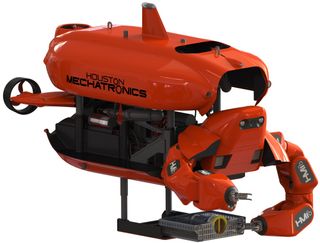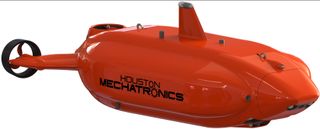Former NASA Engineers Building Real-Life Underwater Transformer

A transformer designed to do grunt work for the oil industry and military is coming, and it's… admittedly kind of fun to look at.
Houston Mechatronics, a small company founded and led by a team of former NASA robot engineers, announced May 1 some major strides toward building a transforming submersible the company calls "Aquanaut." The 2,315-pound (1,050 kilograms) unmanned underwater vehicle (UUV) will transform itself in order to operate in two modes, according to the company: a sleek, submarine-shaped autonomous underwater vehicle (AUV) mode, and an unfolded, two-armed remotely operated vehicle (ROV) mode for work.
"When Aquanaut moves through the water, we want as little drag as possible to extend the maximum range of what the vehicle can do on battery power," Houston Mechatronics spokesperson Sean Halpin said. "By enclosing the limbs, we're able to operate the vehicle over great distances, up to 200 kilometers [124 miles]." [24 Underwater Drones – The Boom in Robotics Beneath the Waves]
The underwater drone's two big selling points, Halpin told Live Science, are its long arms and long range. Each arm is a significant chunk of the Aquanaut's length — 9 feet 6 inches (2.9 meters) in AUV mode, and 11 feet 6 inches (3.5 meters) in ROV mode — and highly articulated for a number of tasks requiring dexterity. Halpin said that the arms are the only part that's been fully completed, but that they're the most difficult bit to design.

The first challenge of Aquanaut, he said, was "elegance." The company worked to come up with a design that was fully transformable and highly functional in ROV, mode while using as few moving parts as possible."As you can imagine, things that move may break," he said. "Now, if you see the Transformers in the Michael Bay movies they have a million little parts that are moving when they transform. That would not be how a normal robot would do it."
The second challenge was intelligence, he said. Aquanaut, like all long-distance robot subs, has to function miles away from its home base, where the connection speed between it and its human controller might be just a "fraction of dial-up," so really weak, Halpin said.
That means that even as it obeys general instructions from its human controller, it has has to do a lot of its detailed decision-making on its own. Aquanaut is designed to inspect itself for damage and make fine motor adjustments under its own guidance.
Sign up for the Live Science daily newsletter now
Get the world’s most fascinating discoveries delivered straight to your inbox.
Aquanaut is being funded primarily by the Defense Department and oil industry, according to Defense One.
Halpin said that Aquanaut's first fully-assembled underwater "tank test" should happen in the coming months, and that Houston Mechatronics expects to start marketing the robot to individual clients in 2019.
Originally published on Live Science.

